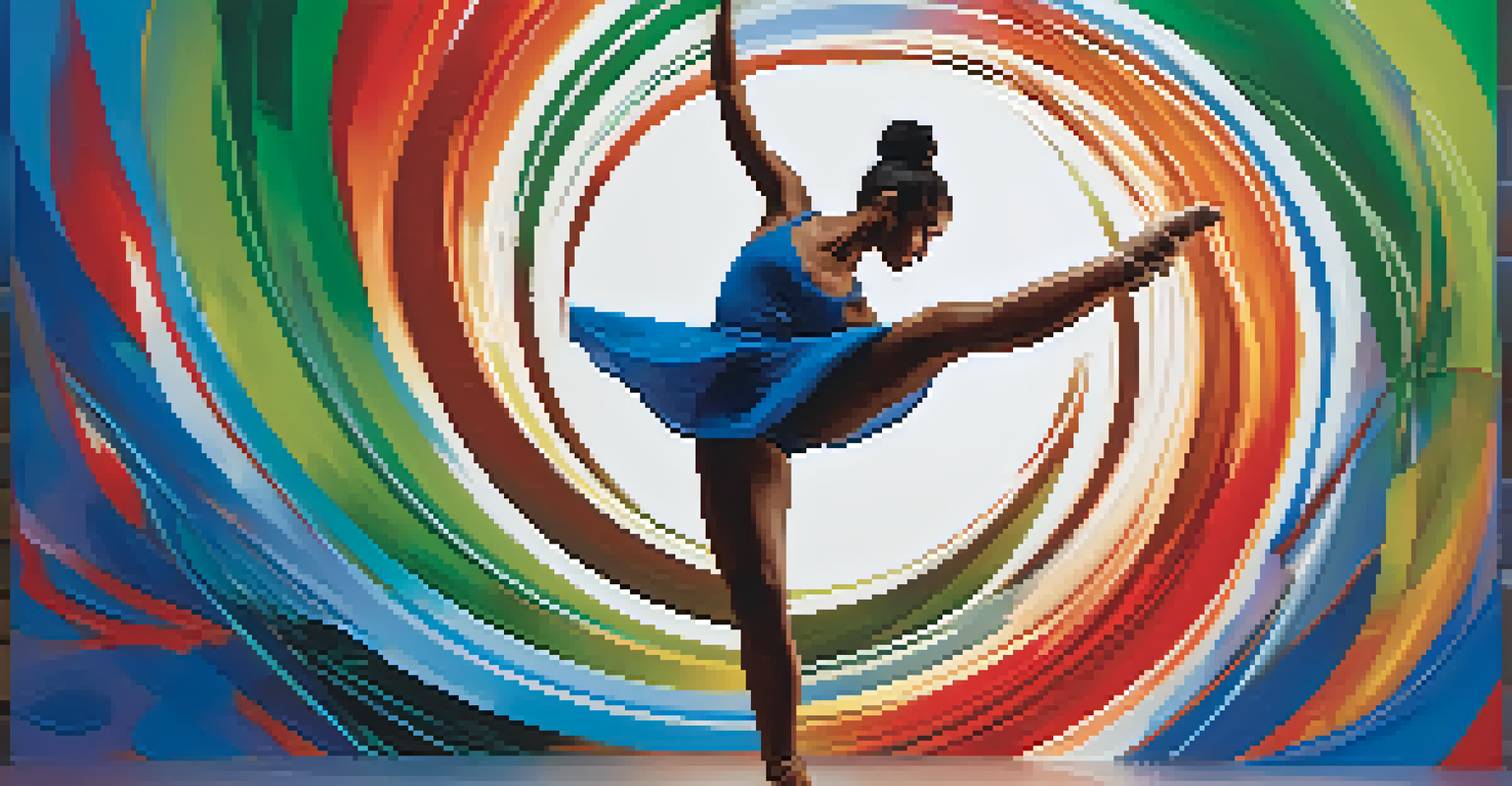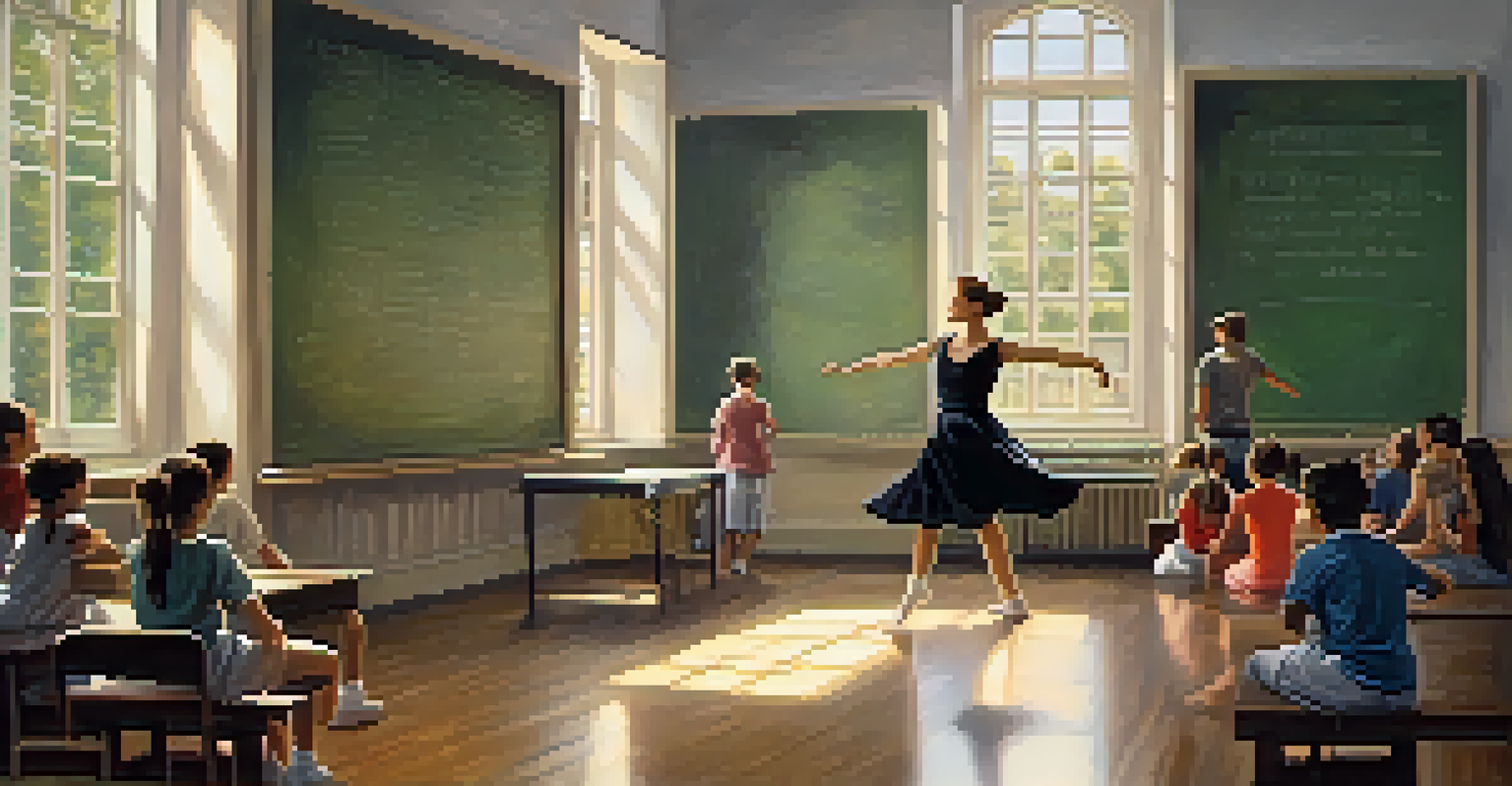Labanotation: A Comprehensive Guide to Its Principles

Understanding Labanotation: An Overview of Its Origins
Labanotation, developed by Rudolf Laban in the early 20th century, serves as a revolutionary system for notating dance. It allows choreographers and dancers to document movement in a visual format, making it easier to preserve and share dance works across generations. This method not only captures the physical movements but also conveys the nuances of dynamics and expression involved in dance.
Dance is the hidden language of the soul.
The origins of Labanotation are deeply rooted in the pursuit of understanding human movement. Laban believed that dance could be analyzed and codified, much like music notation for composers. This innovative approach has since become a vital tool in dance education and choreography, bridging the gap between creation and preservation.
Today, Labanotation is utilized by dancers, choreographers, and researchers globally. It has influenced various dance forms and educational practices, providing a common language for movement analysis. Understanding its history helps appreciate its significance in the dance community.
The Basic Components of Labanotation Explained
At the core of Labanotation are symbols that represent various elements of movement, including direction, duration, and dynamics. These symbols are organized in a way that allows a dancer to visualize the choreography in a structured format. Each symbol corresponds to specific movements, making it easier for dancers to interpret and replicate the choreography accurately.

The notation system includes several key components: the staff, which provides a visual framework; the symbols, which depict the movements; and the color coding that highlights the dynamics of the dance. For example, a symbol for a jump may differ in color from one representing a turn, indicating the energy and style of the movement involved.
Labanotation's Historical Importance
Labanotation, created by Rudolf Laban, revolutionized dance documentation, enabling the preservation and sharing of choreography across generations.
Understanding these components is essential for anyone interested in dance notation. By familiarizing themselves with the symbols and their meanings, dancers and choreographers can enhance their ability to communicate movements effectively. This not only aids in learning but also enriches the overall dance experience.
Reading Labanotation: A Step-by-Step Guide
Reading Labanotation may seem daunting at first, but with practice, it can become an intuitive process. Start by familiarizing yourself with the basic symbols and their meanings, gradually moving on to more complex notations. Just like learning a new language, patience and repetition are key to mastering Labanotation.
Dance is the joy of movement and the heart of life.
Begin with simple phrases of movement, focusing on one symbol at a time. As you grow more comfortable, try to read short notated sequences of dance. This practice will help you develop a deeper understanding of how the symbols translate into actual movement, building your confidence along the way.
Once you grasp the basics, you can explore more intricate notations. Engaging with Labanotation through workshops or classes can also provide practical insights, allowing you to apply your knowledge in real-world contexts. Remember, every dancer starts somewhere, and practice makes perfect!
The Role of Dynamics in Labanotation
Dynamics play a crucial role in Labanotation, as they express the quality and energy of movement. In dance notations, dynamic symbols illustrate how a movement is executed, whether it is sharp, flowing, heavy, or light. This aspect adds depth to the choreography, helping dancers convey emotion and intent through their movements.
Understanding dynamics allows choreographers to communicate their artistic vision more clearly. For instance, a gentle, flowing movement can evoke a sense of calm, while a sharp, abrupt action may create tension. By incorporating dynamics into Labanotation, the emotional impact of the dance is enhanced, making it more engaging for both performers and audiences.
Understanding Dynamics Enhances Dance
Incorporating dynamics into Labanotation allows dancers to convey emotion and intent, enriching the storytelling aspect of performances.
Dancers trained in reading dynamics within Labanotation can interpret performances more effectively. This knowledge empowers them to make informed choices about how to deliver movements, ultimately enriching the storytelling aspect of dance.
Applying Labanotation in Dance Education
Labanotation has found its way into dance education, providing students with a valuable tool for learning and creating choreography. By studying Labanotation, students can gain insights into the structure of movements, fostering a clearer understanding of dance as an art form. This approach encourages critical thinking and analytical skills that benefit dancers in their training.
In classrooms, teachers use Labanotation to teach students how to break down complex choreography into manageable parts. This method enables students to learn faster and more effectively, as they can visually reference the notation while practicing. Additionally, it promotes collaboration, as students can share their choreographic ideas with one another using a common language.
The inclusion of Labanotation in dance curricula also prepares students for professional careers. Many dance companies and organizations value dancers who can read and interpret notation, as it streamlines the rehearsal process and enhances creativity. This skill set not only sets students apart but also enriches the overall dance community.
Challenges in Learning Labanotation
Despite its many benefits, learning Labanotation can come with its challenges. The intricate symbols and their meanings can initially feel overwhelming, especially for those who are new to dance notation. It requires time and dedication to become proficient, and some learners may struggle with the visual-spatial aspects of interpreting the symbols.
Additionally, without proper guidance, students may misinterpret the symbols or overlook important nuances in the notation. This highlights the importance of seeking quality instruction from experienced educators who can provide clarity and support throughout the learning process. Engaging with peers in study groups can also foster a collaborative environment that enhances understanding.
Labanotation in Dance Education
Labanotation is a valuable educational tool that helps students break down complex movements, fostering critical thinking and creativity in choreography.
However, overcoming these challenges can be incredibly rewarding. As learners gain confidence and experience, the ability to read and write Labanotation opens up new avenues for creativity and expression. Embracing the learning journey, with its ups and downs, ultimately leads to a deeper connection with the art of dance.
The Future of Labanotation in Dance
As the world of dance continues to evolve, so does the relevance of Labanotation. With advancements in technology, new tools and resources are emerging to simplify the notation process. For instance, digital platforms are being developed to create and share Labanotation more efficiently, making it accessible to a broader audience.
Furthermore, the growing interest in interdisciplinary collaborations is prompting artists to explore Labanotation in innovative ways. Dancers, choreographers, and researchers are experimenting with integrating Labanotation into various art forms, such as theater and multimedia performances. This cross-pollination of ideas enriches the dance landscape and fosters creativity.

Looking ahead, the future of Labanotation appears promising. As more educators and institutions integrate it into their programs, the appreciation for this notation system will only continue to grow. By embracing change while honoring its rich history, Labanotation can remain a vital resource for dancers and choreographers in the years to come.